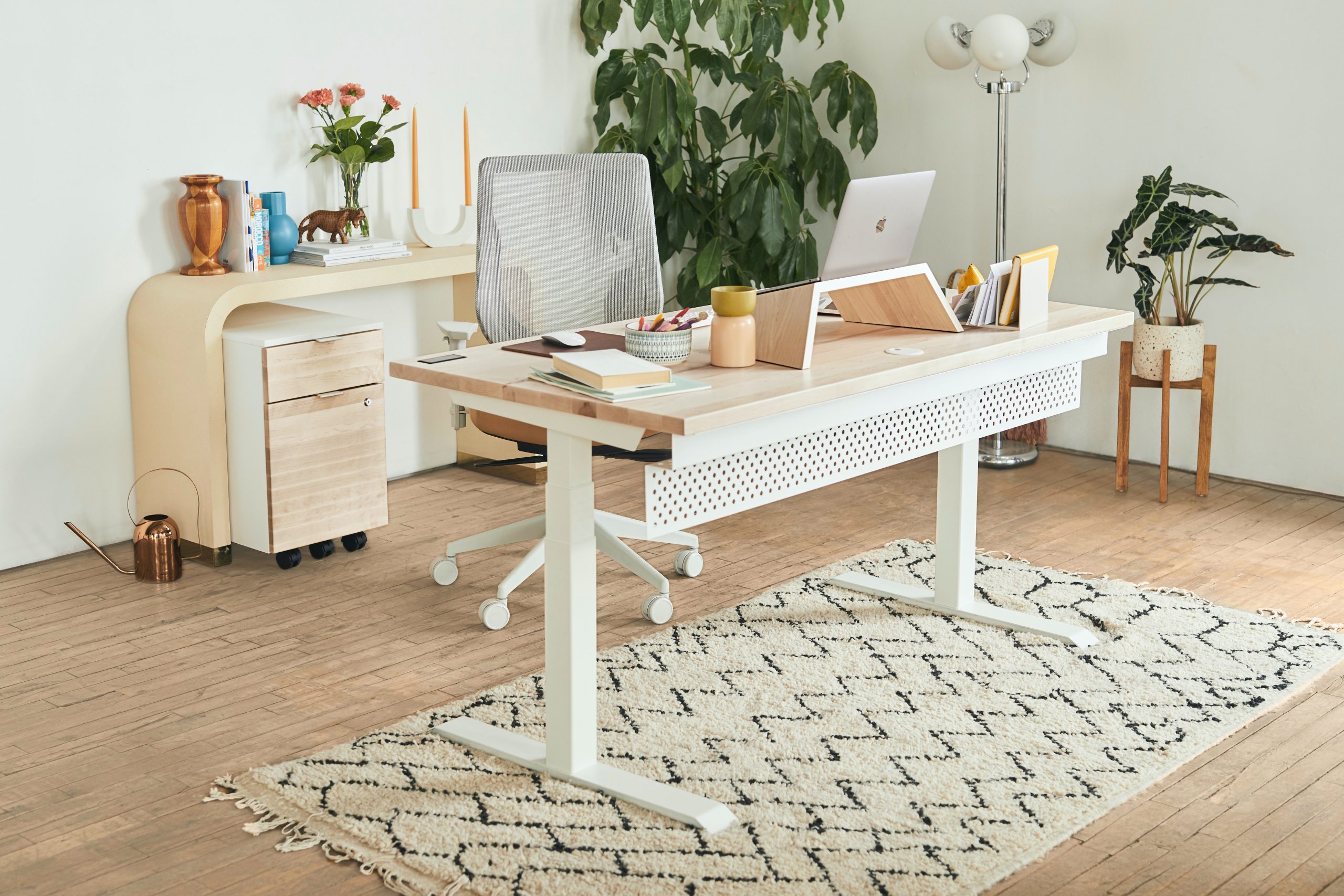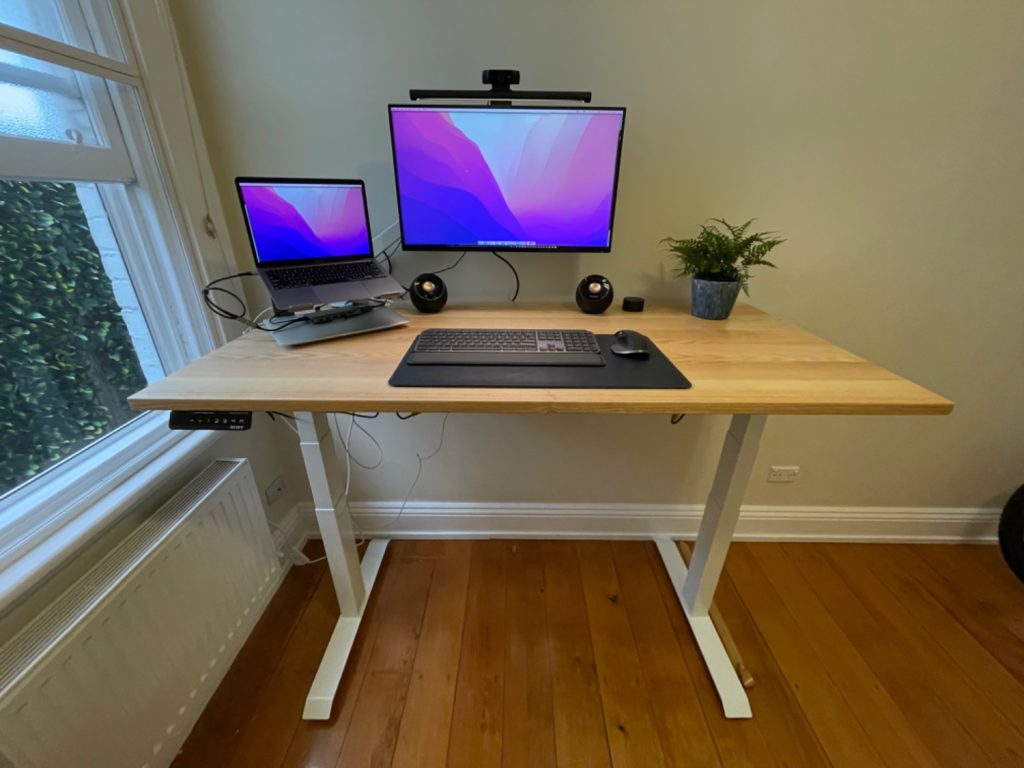Phone:
(701)814-6992
Physical address:
6296 Donnelly Plaza
Ratkeville, Bahamas.

Last Updated on:
It’s 2023, and your desk job is making your entire body feel like you’re aging! Now what? It’s high time to get yourself a sit-stand desk! In recent years, standing desks have risen in popularity. They’re great at allowing you to alternate between sitting and standing without compromising productivity. With prolonged sitting being one of the major causes of back pain, standing desks promote a healthier and more active workspace. In this article, we’ll discuss everything you need to know about how to use a standing desk to reap all its health benefits. This includes how long you should spend standing or sitting, the advisable posture, and other tips and tricks on standing desk use. Let’s dive in!
When deciding which best standing desk works for you, you can either consider a fixed-height desk or an adjustable one.
In most cases, standing desks, also called sit-to-stand desks, are designed to have adjustable sitting and standing heights.

The first step to help you decide on a new standing desk to buy is understanding different standing desk mechanisms. An office furniture dealer should be able to explain the basics to you.
But in essence, consider adjustability, stability, and size. Look for a height-adjustable standing desk that’s easy to raise or lower to accommodate both sitting and standing positions.
Also, consider whether the desk has enough surface area to hold all your essential work tools and whether it can function without wobbling and shaking.
If most desks you see have standing heights too tall for you, you may want to find the best standing desk for short individuals.
Ensure your standing desk setup is tidy and organized to optimise your productivity.
Take time to de-clutter your desk space. Use cable management solutions like brackets to keep cords and wires arranged. Keep frequently used items within reach on your sit-stand desk too.
Using an ergonomic chair and a standing desk mat is also important when setting up your workspace. This should help prevent any back pain and discomfort.
Remember that your height-adjustable desk should be at the right standing height so you don’t keep changing positions. You might think these are small details, but they greatly affect your efficiency and productivity.
Having the correct height and distance from your computer screen is crucial for maintaining the ideal posture. You should take this step seriously to avoid strain on your neck and eyes!
When setting up your new standing desk properly, position your primary monitor at eye level, directly in front of you, at an arm’s length away. That’s about the distance from the tip of your middle finger to your elbow.
If your computer monitor is too low, we recommend using monitor arms or a laptop stand to achieve the ideal height. You don’t want to look down or hunch forward for long hours.
This time, to prevent discomfort and strain on your wrists, arms, and shoulders, we highly encourage you to consider ergonomic keyboard and mouse placements too.
First, position your keyboard where your forearms are parallel to the floor and your elbows at a 90-degree angle.
Your wrists should be in a neutral position, not bent or extended. Your mouse should be within easy reach and at the same level as your keyboard.
When standing, we recommend having your wrists slightly more tilted upwards than when seated on an office chair.
If you’re using your laptop’s main screen, using an external wireless mouse and a separate keyboard is ideal. This saves you the hassle of reaching forward whenever you need to use them.
Using a sit-stand desk will take some getting used to. It takes time to make a desk taller than your usual desk!
It is always important to care for your health, and the standing desk was created so that people do not need to sit for 8 hours a day while sacrificing their physical health.
To maximize its health benefits and to alleviate back pain using a standing desk, get to know these concepts:
Using your new standing desk and taking turns standing or sitting throughout the day should help avoid body pain. But you’ll still feel back pain if you stand or sit with poor posture.
Follow these tricks to maintain the correct posture and prevent any discomfort:
Whether standing or sitting on an office chair, maintaining a neutral position on the wrists when typing or using a mouse is crucial.
Do not extend or flex your wrists too often and repeatedly, or you risk developing carpal tunnel syndrome.
Follow the tips below to prevent straining your arms, wrists, and hands:
Another aspect of good posture when standing is attention to foot positioning and weight support. This helps maintain overall stability, and it reduces fatigue too.
Stand properly by keeping your feet shoulder-width apart, and your knees bent slightly. This posture helps alleviate pressure on your lower back and encourages better circulation.
Consider using an anti-fatigue or cushioned floor mat to support and reduce strain on your feet and legs.
Finding the right desk height is crucial for your comfort and productivity. The optimal standing desk height is unique to every person.
Ideally, your desk’s height should keep your monitor at eye level. Meanwhile, your elbows should rest on your keyboard at a comfortable 90-degree angle.
Experiment with different heights to find the position that feels most convenient for you, not to mention its functionalities, like the electric motor.
Remember that your posture and comfort should be your primary considerations when determining the optimal desk height.
If you need help troubleshooting a stuck standing desk or if there is a button that is malfunctioning, review the manuals your standing desk manufacturer provided.
Maintaining a healthy and natural position when working at your standing desk is important.
Using an ergonomic chair in a seated position and an anti-fatigue mat while standing are great means of support.
Here are some more strategies to help you feel comfortable whether you’re standing or sitting at your work desk throughout the day:
Standing all day can have as many drawbacks as sitting all day too. It’s important to balance the two.
If you’re new to using a standing desk, start with short standing sessions and gradually increase the duration.
Begin by standing for 15-30 minutes every hour, and then gradually extend your standing intervals as your body adjusts to the shift. Listen to your body and take breaks to avoid overexertion or fatigue.
Changing positions occasionally promotes blood flow and helps relieve strain on any body part.
As previously mentioned, finding the balance between durations of standing and sitting throughout the day is necessary to attain comfort. If you are irate at work, your productivity will suffer.
When too engrossed with work, we often lose mindfulness of our bodies.
Use a timer to check how much time you’ve spent standing or sitting. Once your timer goes off, check whether or not you’re still maintaining proper posture.

Set a reminder to switch between positions at regular intervals. Aim for a ratio of approximately 2:1 between sitting and standing.
Once you’ve reached that, match your sitting and standing times by 1:1, depending on your comfort level and work requirements.
Find a rhythm that works best for you!
Every human body is created uniquely. The comfort and energy levels of one person may not apply to you. That’s why paying attention to how your body feels while using a standing desk is crucial.
If you experience discomfort or pain, adjust your posture, take breaks, or consult an ergonomic specialist to ensure proper alignment and ergonomics. Using a seat cushion in case you feel discomfort when seated works too.
Shifting your weight from heel to toe and foot to foot can help with pain in your feet and relieve strain on other muscle groups when in a standing position.
Remember to listen to your body’s signals and make necessary adjustments.
We often hear that sitting too long at a work desk is unhealthy. However, standing too long has its fair share of health risks too.
That means a good balance between standing and sitting is what is necessary.
But in case you catch yourself often standing too long, here are ways to prevent its negative effects:
Standing for prolonged periods can strain your feet, legs, and back.
Anti-fatigue mats are designed to help cushion your feet and promote blood flow. These mats comfort your sore feet and legs and help fight tiredness.
They also encourage movement, keeping you active by slightly changing your position.
Always keep both feet firmly planted on the ground. This will prevent fatigue and improve your overall balance and stability, whether you’re standing or in a seated position.
However, to achieve this, sometimes the correct posture isn’t enough. You have to wear comfortable shoes, too!
Choosing the right footwear is essential when using a standing desk. Opt for supportive shoes that provide cushioning and arch support.
Avoid high heels or shoes that place excessive strain on your feet and ankles as much as possible. Orthotic inserts or insoles can also offer additional support and comfort.
Staying in one position for prolonged periods at your sit-stand desk is not advisable. Not only does it lead to muscle pain, but it can risk other health concerns like heart ailments and weight gain.
Incorporate movement and stretching into your work routine to counteract the negative effects of prolonged standing.
Take a short walk during your break, stretch your legs, and engage in light exercises. Simple movements like shoulder rolls, neck stretches, and calf raises can help improve blood flow and reduce muscle tension.
Check out these FAQs for new standing desk users. Hopefully, you’ll find them helpful!
If you stand for prolonged periods, you increase the risk of discomfort and fatigue in your leg muscles. To optimally use a standing desk, figure out your ideal standing time.
Everyone has a different tolerance for standing, especially when starting.
It’s best to start by standing for shorter periods, such as fifteen minutes to half an hour. You can gradually stand for extended periods as your body adjusts.
Aim for a healthy balance between sitting and standing throughout the day. If you switch between positions at least once every hour, you should achieve a good balance.
The optimal height for a standing desk depends on your body’s proportions and comfort level.
Adjust your desk height so your elbows are at a 90-degree angle when typing and your monitor is at eye level.
It’s understandable to be uncomfortable while your body is adjusting to the new desk. It’s okay to experiment with different heights that work best for you.
Position your monitor at eye level directly in front of you and at an arm’s length away when you stand and are seated. Regularly adjust your screen position to maintain optimal ergonomics as you change positions.
Use a monitor stand or an adjustable monitor arm to achieve more control over your comfortable height and distance.
While standing desks offer numerous benefits, they may not suit everyone. Some individuals may experience leg, foot, or back discomfort when standing for long periods.
You can use a leaning stool and other tools for lumbar support and to keep your feet flat.
Remember to listen to your body. Take breaks and adjust your posture to avoid overexertion or muscle fatigue.
To ensure your standing desk is set up correctly, consider proper screen height and distance, neutral wrist positioning, and good posture.
If you experience any discomfort or pain, it may indicate that your desk setup needs adjustment. Consult an ergonomic specialist for personalized guidance.
Understanding how to use a standing desk has numerous benefits for your health and productivity. You can optimize your standing desk experience today by following these tips and tricks!
Remember to set up your desk correctly, maintain proper posture, take breaks, and listen to your body’s signals.
Purchasing a standing desk will improve your lifestyle, and you won’t notice it until you revert to a usual office setup!
With the right setup and habits, you can enjoy the benefits of a standing desk while working toward a healthier and more active work lifestyle.